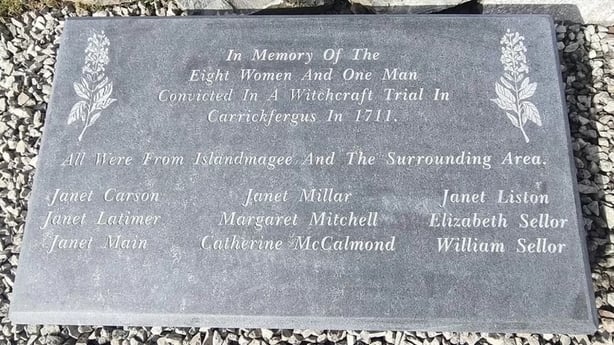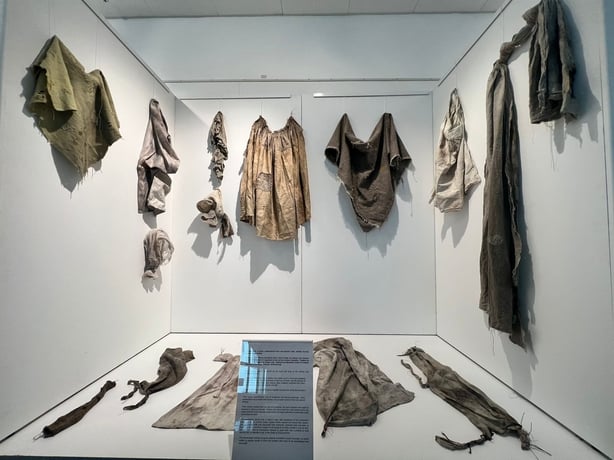Analysis: The Islandmagee witches exhibition is about finding new ways to understand and commemorate Irish witch trials
By Victoria McCollum and Andrew Sneddon, Ulster University
In February 1711, in the peninsula of Islandmagee in north-east County Antrim, the elderly widow of a local Presbyterian minister, Ann Haltridge died in mysterious circumstances. Many thought witches were to blame. A few days later, her educated, eighteen-year-old niece, Mary Dunbar, arrived from Co Down to comfort the grieving family. Almost immediately, Mary began to experience the symptoms of demonic possession: from vomiting foreign objects to convulsions and levitation.
During March 1711, she accused eight women of using magic to conjure demons to possess her body and attack and threaten her in spirit form. The eight women, including a mother and daughter, were convicted of bewitching Dunbar under the Irish Witchcraft Act (1586) on March 31st 1711. They were sentenced to a year's imprisonment and to stand four times in the pillory on market day. A few months later, a further "witch", William Sellor, was convicted. As Mary had died in the time between her initial accusation and the trial, Sellor would have been tried for the capital crime of using witchcraft to kill; the punishment for which was execution.

Recent research has shown that the trial made a deep impression on people living in Islandmagee for hundreds of years after the trial. It was remembered through folklore and a folk history kept alive by places in the landscape associated with the trial.
Continued fear of witchcraft in the area was shaped by the supernatural lingering presence of the 'witches’ up until the 20th century. This interest was matched by that of amateur historians, journalists and creative writers. Their work used the trial to make political points, reinforce accepted gender roles, and distance Ireland from its European witch-hunting past by wrongly suggesting that Islandmagee was the country’s only witch trial because Irish people didn’t believe in witches.
If the Islandmagee ‘witches’ were remembered and commemorated locally and in print, their story was met by silence at an official level in Northern Ireland. This was in stark contrast to other places in Europe and America with significant witch trials that haunted their past. In 2011, the 300 year anniversary of the Islandmagee trial went by almost unnoticed: no academic conferences, exhibitions or commemorative events were held. In 2015, novelist Martina Devlin's plans to erect a memorial to the convicted women was shelved by Larne Borough Council after an objection by a Unionist councillor was raised on the grounds that to do so would be tantamount to Devil worship.

In the last ten years, this social forgetting has been largely addressed. Plays, a novel, and songs have been produced that deal with the trial, as well as Andrew Sneedon's detailed history book about it. In April 2023, the Mid and East Antrim Council erected a plaque to all nine convicted Islandmagee ‘witches’. With the Arts and Humanities Research Council (UK), Ulster University and Connected NI, the council also funded the first exhibition dedicated to them, ‘Reimagining The Islandmagee Witches: An Interactive Exhibition’. The exhibition was developed by the authors with Dr Helen Jackson from Ulster University and Shirin Murphy of Carrickfergus Museum, where it was launched in September of this year.
The exhibition blends new technology with more traditional information panels, objects, maps, manuscripts, books, and images. An art installation reflects the importance of stained and ruined cloth in identifying and socially placing the Islandmagee 'witches' during their prosecution and trial. A Collection of Good, Unblemished Linen and Woollen Cloth, Tainted, Burned, Knotted and Dirtied (2023) was made by Alison Gault and Hazel Bruce of the Belfast School of Art and is based on an article by Andrew Sneedon.
Visitors to the exhibition can also learn about the trial using various digital technologies and creative outputs produced by the Islandmagee Witches 1711 Digital and Creative Project. This project digitised all the original trial documents and created an animated film (see below) which users can watch on our website, or by "lifting" old film reels in the Demonised and Possessed VR app where a VR headset plunges into Islandmagee in 1711 where you can experience what it is like to be bewitched and be accused of witchcraft.
We need your consent to load this Vimeo contentWe use Vimeo to manage extra content that can set cookies on your device and collect data about your activity. Please review their details and accept them to load the content.Manage Preferences
With Ulster University game design lecturers Brian Coyle and Sabrina Minter, we developed a character driven and immersive Serious video game. It has sophisticated decision-making mechanics, a detailed storyline, high quality graphics, and is set just after the Islandmagee trials. In it, you play an investigator sent to examine the case and find out what really happened. We also wrote a graphic novel The Islandmagee Witches with Derry-based graphic artist, David Campbell, which explores themes of horror, history, unreliable narration, gender, and belief in a visually and textually striking way.
We knew it already, but we really know it now by working on this exhibition and the wider project: academics don't have all the answers and historical knowledge about hidden histories can and should be co-produced in diverse and innovative ways by many hands.
The views expressed here are those of the author and do not represent or reflect the views of RTÉ

